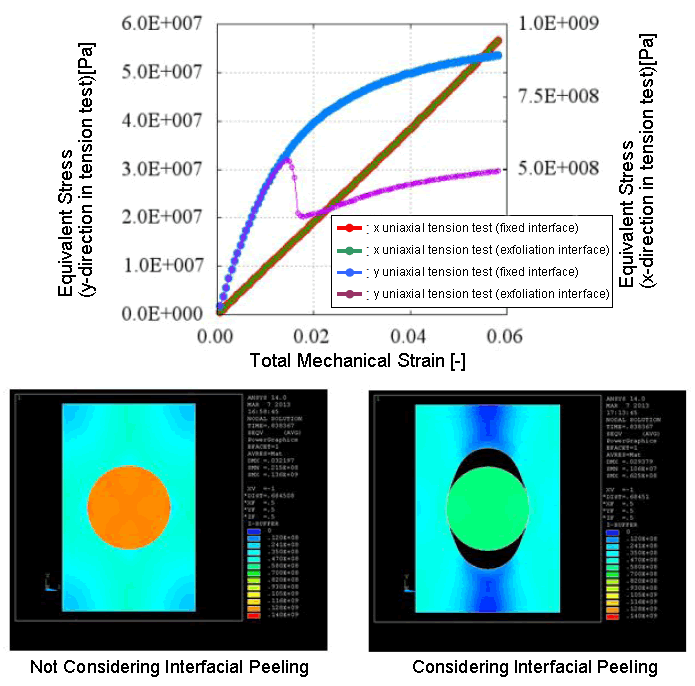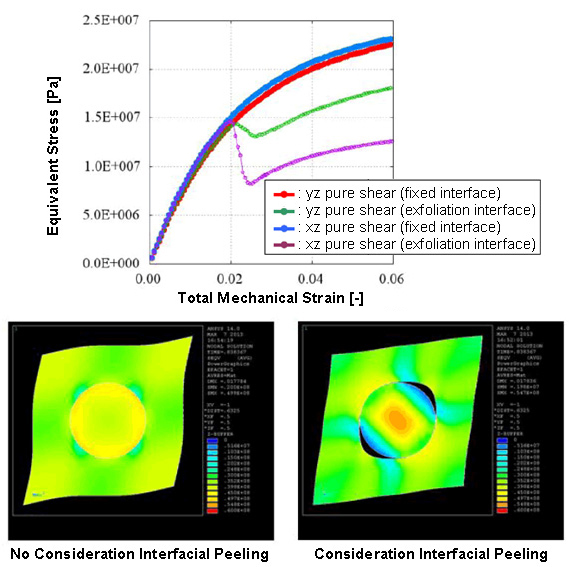It is possible to define all non-linear material models held in ANSYS freely to the micro model and those effects can take into account a numerical material test in the non-linear version CMAS. This analysis example introduces numerical material test that takes into account the resin internal cracking progression and interfacial peeling of the FRP fiber matrix.
Numerical material test that takes into account interfacial peeling (simple model)
It is possible to define peeling properties that were specified the critical stress in the tangential component and the normal component to contact interfaces in ANSYS. Figure1 shows the outline of the fiber-reinforced composite material that is reinforced in one direction. Fibers are oriented in the direction perpendicular to the paper surface. Defining the elastic material to the fiber and the elastic-plastic material to the resin, also interfacial peeling properties to the interfacial of resin and fiber.

Figure1. Material Properties Value and Overview of Analysis Model
Performing pure shear and uniaxial tension tests on the numerical material test pieces that are applied to those material models. First, Figure 2 shows the results of the uniaxial tensile test. The macro material response shows both cases: considering interfacial peeling and not considering interfacial peeling. The material response does not depend on the definition whether interfacial peeling characteristics is present or absent, because the stress that promotes peeling on the material interface does not work in the uniaxial tensile test in x direction (the direction of the fiber orientation). On the other hand, interfacial peeling occurs in the uniaxial tensile test in a direction perpendicular to the fiber because the stress is acting in the normal direction of the interface. In accordance with peeling occurring, the apparent rigidity can be observed as extremely small since between the interfaces are no longer transferring stress.

Figure2. Equivalent stress contour and macro material response during the uniaxial tensile test
Figure3 shows result of pure shear test. You can see the rapid stiffness change accompany the interfacial peeling, similar to the uniaxial tension test.

Figure3. Equivalent stress contour and macro material response during the pure shear test
So far, we have shown the example analysis results in simplified model that is modeling only one fiber. The important point here is to assume the periodic symmetry in all directions in numerical material test of CMAS. In other words, this case corresponds to the result of whole materials behavior, not only to the one fiber model. When peeling starts on the interface of the one fiber, all fiber interfaces in the whole material began peeling at the same time. Detailed analysis model, which is a more detailed expression in the unit cell with a plurality of fibers, is required in order to take into account the damage behavior conforming to the actual phenomena.
Numerical material test that takes into account the crack propagation in resin (detailed model)
Introducing an example of numerical material test that takes into account the crack propagation in resin to the model having a detailed fiber distribution. In ANSYS, it is possible to perform the analysis that simulates the destruction of the element. It is possible to apply various indicators such as the maximum strain, maximum stress, or combination of those as fracture criteria. The element that reaches the specified reference value can be used to simulate the destruction by setting to lower rigidity in any ratio.
Figure4. shows the numerical material test results that take into account the destruction of the one-direction-reinforced model (but fiber positions are distributed). Element destruction occurs locally from the stress concentration location and the apparent rigidity drops. You can see the state that macro rigidity disappears (material is completely destroyed) at the stage of destruction area is progressed with increasing macro strain, and both ends of the model led to the destruction region.

Figure4. Uniaxial tensile numerical material test that takes into account the crack propagation in resin
Analysis Types
Numerical Material Test、Elasto-plastic Analysis、Damage Analysis
